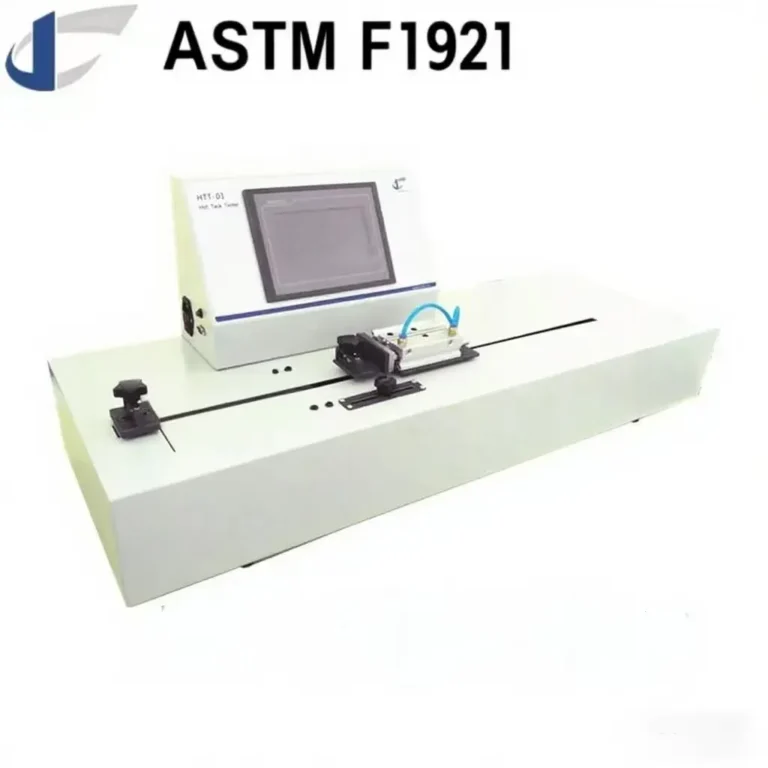Hot Tack Test: Ensuring Seal Strength in High-Speed Packaging Lines
In flexible packaging, maintaining seal integrity during high-speed production is critical. One of the most vital performance indicators is the kiểm tra độ dính nóng, which evaluates a seal’s strength while it’s still hot—before the packaging cools. This test is essential in applications like Con dấu điền đầy dạng đứng (VFFS), where the seal must hold while the product is inserted immediately after sealing. For packaging professionals and QA teams, understanding hot tack performance helps avoid seal failures, leaks, and product recalls. This article explores the kiểm tra độ dính nóng, its methods, and how modern testers like Cell Instruments’ HTT-01 enhance accuracy and efficiency.
Understanding Hot Tack Strength, Hot Tack Meaning, and ASTM F1921
To fully grasp the concept of sức mạnh dính nóng, one must first understand hot tack itself. Hot tack refers to the ability of a heat-sealed joint to withstand mechanical stress while still hot—typically before it reaches ambient temperature.
According to Tiêu chuẩn ASTM F1921, the kiểm tra độ dính nóng involves sealing a plastic film at a defined temperature, pressure, and dwell time, followed by a short cooling phase. Then, a tensile force is applied to measure the strength of the hot seal. This process mimics real-world packaging conditions, especially in high-speed lines where cooling is minimal.
Hot tack strength is typically expressed in Newtons (N) and reflects the immediate seal holding power. A higher hot tack force means a stronger, more reliable seal right after bonding.
Các hot tack test method under Tiêu chuẩn ASTM F1921 includes:
-
Preparing test strips of flexible film (usually laminates or mono-layer films).
-
Sealing them using heated jaws at controlled parameters.
-
Applying tension to the sealed area before full cooling.
-
Measuring the peak force required to break the seal.
These results help packaging engineers select films and optimize sealing parameters that offer both seal strength and process efficiency.
Why Hot Tack Test Matters in Packaging Applications
In packaging, the kiểm tra độ dính nóng is particularly useful for:
-
Snack food pouches that are immediately filled and dropped into secondary packaging.
-
Pharmaceutical pouches requiring secure seals under thermal or mechanical stress.
-
Frozen food packaging, where cold chain operations demand strong seals from the start.
-
High-speed automated packaging lines, where insufficient cooling can compromise seal integrity.
A poor hot tack seal may appear fine after cooling but may fail during handling or distribution if it doesn’t hold initially.
By using a reliable hot tack testing instrument, manufacturers can:
-
Predict and prevent seal failure.
-
Choose appropriate sealants and film combinations.
-
Optimize sealing equipment parameters.
-
Validate packaging against ASTM F1921 or internal specifications.
Introducing Cell Instruments HTT-01 Hot Tack Tester
To ensure reliable hot tack performance, precise and repeatable testing is crucial. Cell Instruments’ HTT-01 Hot Tack Tester is a high-performance solution combining hot tack, tensile, and peel testing in a single device.
Key features include:
-
PLC-based control for industrial-grade performance and stability.
-
User-friendly HMI touch screen for intuitive parameter setting.
-
Delta PID temperature controllers for precise thermal regulation.
-
Sealing jaws with uniform aluminum encapsulation for consistent sealing.
-
Adjustable testing speed (1–2000 mm/min) for different film types and requirements.
-
Safety systems like overload and over-travel protection for secure operation.
With HTT-01, users can follow Tiêu chuẩn ASTM F1921 precisely, simulate real sealing conditions, and ensure packaging quality under thermal and mechanical stress.
Real-World Applications and Industry Use Cases
Industries that benefit from hot tack testing include:
-
Food packaging: chips, cookies, sauces, and frozen meals.
-
Medical device packaging: where sterile barrier integrity must be maintained under heat stress.
-
Pharmaceutical products: blister packs, sachets, and unit doses.
-
Personal care: creams and gels filled in flexible sachets.
The test ensures packaging can withstand internal product pressure and external mechanical handling immediately after sealing, reducing the chance of leakers or returns.
Conclusion

Các kiểm tra độ dính nóng is essential for validating the integrity of heat seals during the most vulnerable sealing phase—while still hot. Understanding sức mạnh dính nóng, hot tack meaning, and implementing standards like Tiêu chuẩn ASTM F1921 allows companies to optimize packaging design and performance.
Leveraging advanced tools like the Máy kiểm tra độ bám dính nóng HTT-01 from Cell Instruments ensures consistent, accurate, and efficient evaluation of flexible packaging seal strength, supporting high-speed production without compromising quality.
